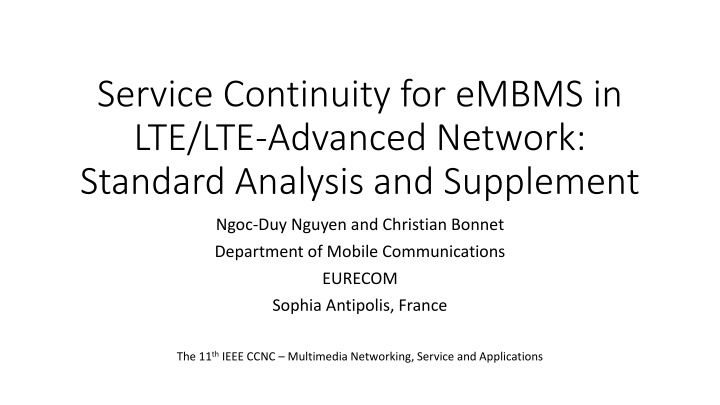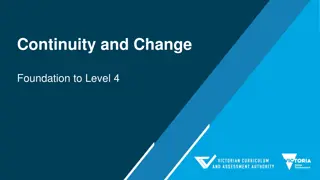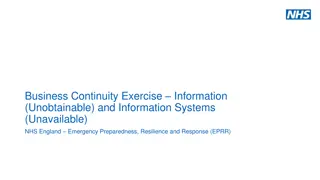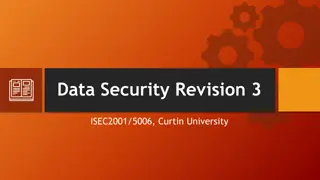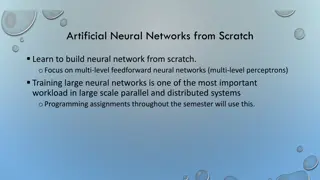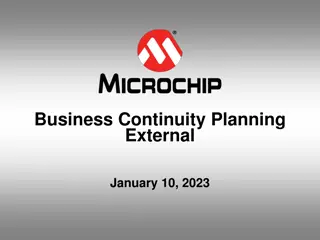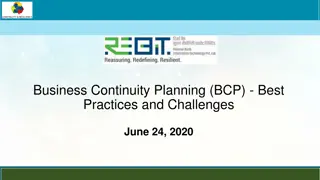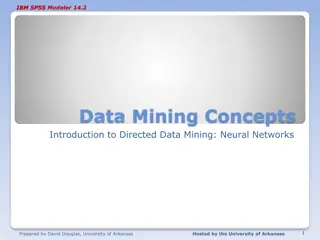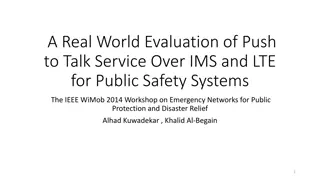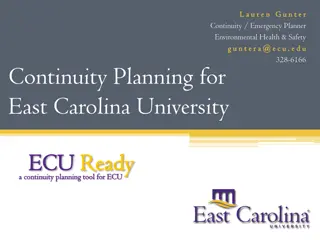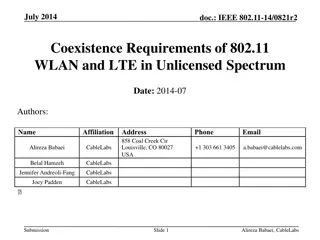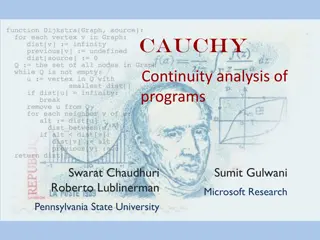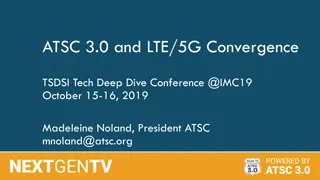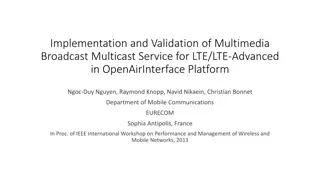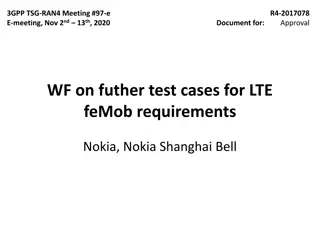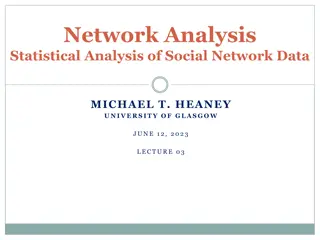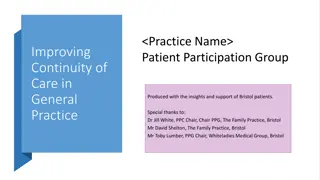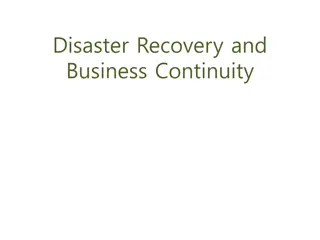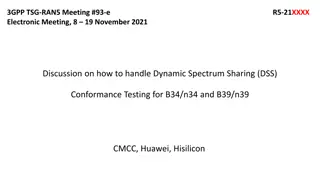Service Continuity for eMBMS in LTE/LTE-Advanced Networks: Standard Analysis
The paper discusses service continuity for eMBMS in LTE/LTE-Advanced networks, addressing current limits and background knowledge on MBMS over a Single Frequency Network. It highlights the motivation, commercial aspects, and mobility cases related to eMBMS services.
Download Presentation

Please find below an Image/Link to download the presentation.
The content on the website is provided AS IS for your information and personal use only. It may not be sold, licensed, or shared on other websites without obtaining consent from the author.If you encounter any issues during the download, it is possible that the publisher has removed the file from their server.
You are allowed to download the files provided on this website for personal or commercial use, subject to the condition that they are used lawfully. All files are the property of their respective owners.
The content on the website is provided AS IS for your information and personal use only. It may not be sold, licensed, or shared on other websites without obtaining consent from the author.
E N D
Presentation Transcript
Service Continuity for eMBMS in LTE/LTE-Advanced Network: Standard Analysis and Supplement Ngoc-Duy Nguyen and Christian Bonnet Department of Mobile Communications EURECOM Sophia Antipolis, France The 11thIEEE CCNC Multimedia Networking, Service and Applications
Motivation To meet the growing demand for mobile multimedia services, the Third Generation Partnership Project (3GPP) has defined the Multimedia Broadcast Multicast Service (MBMS) [1] as a solution for delivery multimedia content to a large number of users at the same time. With the improved performance thanks to OFDM and single frequency network (SFN) in LTE, eMBMS is now considered as the main competitor to the well known Digital Video Broadcasting (DVB) technology.
Commercial eMBMS Qualcomm Labs in conjunction with Verizon Wireless and infrastructure provider Ericsson have showed their first commercial demonstration of LTE Broadcast eMBMS and announced plans to launch the services in 2014. Hauwei, Samsung .
Current limits The service continuity for LTE broadcast is still very limited in the standard. Service continuity for user equipments (UE) that are using eMBMS while being mobile plays an important role in maintaining service quality.
Background Knowledge MBMS over a Single Frequency Network (MBSFN) transmission is a technique that allows multiple cells transmit the same content using an identical waveform at the same time.
MBSFN Area: Except for the MBSFN Area Reserved Cells, all cells within an MBSFN Area contribute to the MBSFN Transmission and advertise its availability. Reserved Cell: A cell within a MBSFN Area which does not contribute to the MBSFN Transmission MBMS Service Area: The area within which data of a specific MBMS session (or service) are sent. Each individual MBMS session of an MBMS Service may be sent to a different MBMS Service Area. An MBMS Service Area may include one or more MBSFN Area.
Mobility Case 1: The UE is receiving an eMBMS service and moving to an MBSFN Area reserved cell. Case 2: The UE moves to a target eNB which is in the same MBSFN Area with serving eNB. Case 3: The UE moves to a new eNB which does not belong to the same MBSFN Area with the serving eNB.
Service Continuity in LTE Standard(Rel 10) UEs in RRC-Idle state will perform reselection procedure and in RRC- Connected state, they will follow the normal handover procedure in unicast transmission. No new information is provided to help the UE in switching reception between MBSFN Areas neither.
Connected Mode measures the attributes of neighboring cells while moving serving cell will decide to make handover if necessary Source eNB sending a Handover Request to the target eNB.
Connected Mode Cont. If(radio resources are allocated){ listen to eMBMS control information //SIB13 if(same MBSFN Area){ if(Interested) continue MBMS; else return; }else{ listen to the MCCH (information of a particular service) if(Available && Interested) continue MBMS else return } }else{ return }
Idle Mode UE performs cell reselection to support the mobility UE obtains the broadcast information from neighbor cells Choosing one eNB with the highest priority UE will check SIB13 and MCCH message in new cell
Surely maintained in the same MBSFN Area The service continuity can be surely maintained only in the case where the source and target cell are in the same MBSFN Area. With the other cases, there is a possibility that the eMBMS service could be dropped. Source eNB (or UE) decides to hand UE over a target eNB without knowing which eMBMS services are available.
3GPP Rel-11 modified With the multi-frequency deployment in LTE network, eMBMS services can be provided on more than one frequency. Supplements were introduced to support the continuity of eMBMS by guiding UEs to find their interested services on other frequencies.
More information are provided to UEs The network informs UEs which eMBMS services are provided on which frequency through a combination of : 1. User Service Description (USD) : Service ID, Temporary Mobile Group Identity, frequencies and the MBMS Service Area Identities 2. System Information Block Type 15 (SIB15): list of neighboring frequencies UE can determine which frequency provides the eMBMS services it is receiving or interested in.
Moving out of the cell Idle State : At least one neighbor frequency provides the service -> continuity of eMBMS service is maintained Connected state : MBMS Interest Indicator (UE -> ENB): list of frequencies on which the UE is receiving or interested Source eNB will use this information in choosing the cell to hand the UE over. Target ENB who providing the appropriate eMBMS services will be in first priority
Remaining Problem If there is one frequency is deployed or in the case non of neighbor frequencies provide the desired eMBMS service
Proposed Solutions Taking the information of services provided in the neighbor cells into account when choosing candidates for handover or reselection procedure Focus on the neighbor cells and their supporting eMBMS services instead of the services transmitted on other frequencies Find the neighbor cells that have its interested services in the same frequency with the current cell before searching on the other frequencies.
Discontinuity between MBSFN areas The lack of information about services supported by neighboring cells in other MBSFN Areas may cause the discontinuity. Solution : In the SIB13, the base station should broadcast the list of all eMBMS services (only the service ID or TMGI value) supported by its MBSFN Areas All services listed are supported by neighbor cells on the same frequency with the serving cell.
Continuity in Connected state To ensure the eMBMS continuity, the serving cell needs to know two things: services supported by other cells (referred as MBMS Service Support Information) the services UE is receiving or interested to receive (MBMS Service Interest) but the MBMS Interest Indication in the standard only gives the list of frequencies not services Sol : UE should give it to the serving cell by means of a RRC message
Cont. To avoid the need to read the MCCH message in new eNB, the MCCH message can be sent from target eNB to UE via source eNB. (during the Handover preparation phase) UE can receive the MBMS data once connected to the new eNB -> the interruption time can be reduced If there is no neighbor cell on the same frequency layer provide the desired service, the serving cell will search on other frequencies.
Conclusion & future works Presented and analyzed the service continuity for eMBMS in the current LTE standard improvement to supplement the existing eMBMS service continuity mechanism Future work: Optimization: on the same frequency with the serving cell have higher priority but not best QoS
Implementation in OAI The performance of eMBMS system in OAI platform with a basic scenario (one eNB and several UEs) has met the requirement indicated by the 3GPP standard
Progress Update OAI is unstable when Multiple Users try to register to the same Core Network: EMM_Invalid Both UEs try to register to CN through same eNB or different eNBs Todo Prepare for QAC : slides and presentation Survey eMBMS
